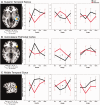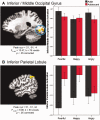Developmental differences in the neural mechanisms of facial emotion labeling
- PMID: 26245836
- PMCID: PMC4692325
- DOI: 10.1093/scan/nsv101
Developmental differences in the neural mechanisms of facial emotion labeling
Abstract
Adolescence is a time of increased risk for the onset of psychological disorders associated with deficits in face emotion labeling. We used functional magnetic resonance imaging (fMRI) to examine age-related differences in brain activation while adolescents and adults labeled the emotion on fearful, happy and angry faces of varying intensities [0% (i.e. neutral), 50%, 75%, 100%]. Adolescents and adults did not differ on accuracy to label emotions. In the superior temporal sulcus, ventrolateral prefrontal cortex and middle temporal gyrus, adults show an inverted-U-shaped response to increasing intensities of fearful faces and a U-shaped response to increasing intensities of happy faces, whereas adolescents show the opposite patterns. In addition, adults, but not adolescents, show greater inferior occipital gyrus activation to negative (angry, fearful) vs positive (happy) emotions. In sum, when subjects classify subtly varying facial emotions, developmental differences manifest in several 'ventral stream' brain regions. Charting the typical developmental course of the brain mechanisms of socioemotional processes, such as facial emotion labeling, is an important focus for developmental psychopathology research.
Keywords: adolescence; brain; development; emotion; face.
Published by Oxford University Press 2015. This work is written by US Government employees and is in the public domain in the US.
Figures




Similar articles
-
Association of Irritability and Anxiety With the Neural Mechanisms of Implicit Face Emotion Processing in Youths With Psychopathology.JAMA Psychiatry. 2017 Jan 1;74(1):95-103. doi: 10.1001/jamapsychiatry.2016.3282. JAMA Psychiatry. 2017. PMID: 27902832 Free PMC article.
-
Facial Expression Enhances Emotion Perception Compared to Vocal Prosody: Behavioral and fMRI Studies.Neurosci Bull. 2018 Oct;34(5):801-815. doi: 10.1007/s12264-018-0231-9. Epub 2018 May 9. Neurosci Bull. 2018. PMID: 29740753 Free PMC article.
-
Adolescents and young adults differ in their neural response to and recognition of adolescent and adult emotional faces.Psychophysiology. 2022 Sep;59(9):e14060. doi: 10.1111/psyp.14060. Epub 2022 Mar 31. Psychophysiology. 2022. PMID: 35357699
-
Distributed and interactive brain mechanisms during emotion face perception: evidence from functional neuroimaging.Neuropsychologia. 2007 Jan 7;45(1):174-94. doi: 10.1016/j.neuropsychologia.2006.06.003. Epub 2006 Jul 18. Neuropsychologia. 2007. PMID: 16854439 Review.
-
Neurocognitive bases of emotion regulation development in adolescence.Dev Cogn Neurosci. 2015 Oct;15:11-25. doi: 10.1016/j.dcn.2015.07.006. Epub 2015 Jul 29. Dev Cogn Neurosci. 2015. PMID: 26340451 Free PMC article. Review.
Cited by
-
The Development of Ambiguity Processing Is Explained by an Inverted U-Shaped Curve.Behav Sci (Basel). 2024 Sep 16;14(9):826. doi: 10.3390/bs14090826. Behav Sci (Basel). 2024. PMID: 39336041 Free PMC article.
-
Preliminary mapping of the structural effects of age in pediatric bipolar disorder with multimodal MR imaging.Psychiatry Res Neuroimaging. 2018 Mar 30;273:54-62. doi: 10.1016/j.pscychresns.2017.12.006. Epub 2018 Jan 10. Psychiatry Res Neuroimaging. 2018. PMID: 29361347 Free PMC article.
-
Emotion processing in youths with conduct problems: an fMRI meta-analysis.Transl Psychiatry. 2023 Mar 30;13(1):105. doi: 10.1038/s41398-023-02363-z. Transl Psychiatry. 2023. PMID: 36997510 Free PMC article.
-
The role of functional emotion circuits in distinct dimensions of psychopathology in youth.Transl Psychiatry. 2024 Aug 2;14(1):317. doi: 10.1038/s41398-024-03036-1. Transl Psychiatry. 2024. PMID: 39095355 Free PMC article.
-
Testing the effectiveness of the culturally adapted skills training START NOW to reduce mental health problems in adolescent refugees: study protocol for a randomized controlled trial.Front Public Health. 2024 Jun 11;12:1408026. doi: 10.3389/fpubh.2024.1408026. eCollection 2024. Front Public Health. 2024. PMID: 38919921 Free PMC article.
References
-
- Brotman M.A., Guyer A.E., Lawson E.S., et al. (2008a). Facial emotion labeling deficits in children and adolescents at risk for bipolar disorder. The American Journal of Psychiatry, 165(3), 385–9. - PubMed
-
- Cohen Kadosh K., Henson R.N., Cohen Kadosh R., Johnson M.H., Dick F. (2010). Task-dependent activation of face-sensitive cortex: an fMRI adaptation study. The Journal of Cognitive Neuroscience, 22(5), 903–17. - PubMed
Publication types
MeSH terms
Grants and funding
LinkOut - more resources
Full Text Sources
Other Literature Sources

